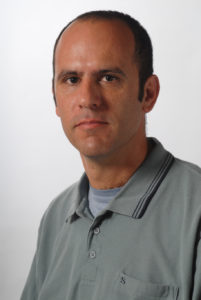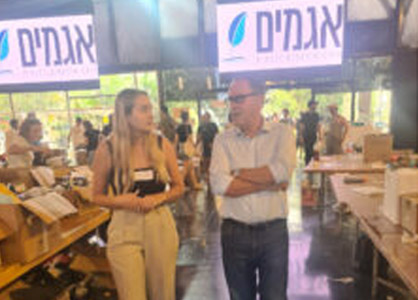
Fish and Humans Perceive Visual Stimuli Similarly
Fish and Humans Perceive Visual Stimuli Similarly
February 7, 2019
Natural Sciences, Press Releases
Humans, fish and, most likely, other species rely on identical visual features ─ color, size, orientation, and motion ─ to quickly search for objects, according to researchers at Ben-Gurion University of the Negev (BGU).
The study published in the Journal of Vision involved target-training of archerfish, a lab model species with unique visual hunting skills that is widely used in experiments to evaluate visual perception.
In their natural habitat, archerfish hunt by spitting a jet of water at insect prey on overhanging leaves to dislodge and eat them. In a controlled lab environment, BGU researchers were able to train the fish to distinguish between objects on a computer monitor above them and shoot at a desired target. By doing so, the fish were able to perform a controlled experiment similar to the way human subjects participate in experiments: simply by watching a computer screen and answering questions.
“The experiments tested archerfish performance in different visual-search tasks in which the target was defined by color, size, orientation, or motion,” says Professor Ronen Segev, head of the BGU Neural Code Lab, and a member of the Department of Life Sciences and Zlotowski Center for Neuroscience. “We found that these four features are processed in the archerfish in a similar way to how humans identify a target amidst distracting shapes and colors.”
Learning more about the features that pop out for different species ─ what is the same and what is different ─ is important in understanding how animals target what they need to survive, reproduce and avoid predators.
“While there is extensive evidence that color, size, orientation, and motion are the most efficient features for guiding a human’s attention, we found the same universal features will also make a target pop out against a busy background for animals with very different brain anatomies and living environments,” says Professor Ohad Ben-Shahar, the chair of BGU’s Department of Computer Science.
While the researchers confirmed that the same four visual search cues for humans and archerfish are similar, the question remains whether this is also true for other vertebrates, birds and amphibians. Their findings also pinpoint difficulties targeting an object with a different shape or juxtaposition within a busy background.
“We can use these results to study the connection between the decision making by the fish and the functional properties of the fish visual system and other parts of the brain,” Segev says. “We recommend future studies delve into the evolutionary and developmental perspectives of what guides visual search in other species.”
The research team also included Adam Reichenthal, a graduate student in BGU’s Department of Life Sciences and the Zlotowski Center for Neuroscience, and Dr. Mor Ben-Tov, a graduate of BGU and now a postdoctoral fellow at Duke University.
Funding was provided by the Israel Science Foundation (Grant 211/15), the Binational Science Foundation (BSF; Grant 2011058), the Frankel Fund at BGU’s Department of Computer Science, and the Helmsley Charitable Trust through the ABC Robotics Initiative of BGU.
ABOUT AMERICANS FOR BEN-GURION UNIVERSITY
By supporting a world-class academic institution that not only nurtures the Negev, but also shares its expertise locally and globally, Americans for Ben-Gurion University engages a community of Americans who are committed to improving the world. David Ben-Gurion envisioned that Israel’s future would be forged in the Negev. The cutting-edge research carried out at Ben-Gurion University drives that vision by sustaining a desert Silicon Valley, with the “Stanford of the Negev” at its center. The Americans for Ben-Gurion University movement supports a 21st century unifying vision for Israel by rallying around BGU’s remarkable work and role as an apolitical beacon of light in the Negev desert.
About Ben-Gurion University of the Negev
Ben-Gurion University of the Negev embraces the endless potential we have as individuals and as a commonality to adapt and to thrive in changing environments. Inspired by our location in the desert, we aim to discover, to create, and to develop solutions to dynamic challenges, to pose questions that have yet to be asked, and to push beyond the boundaries of the commonly accepted and possible.
We are proud to be a central force for inclusion, diversity and innovation in Israel, and we strive to extend the Negev’s potential and our entrepreneurial spirit throughout the world. For example, the multi-disciplinary School for Sustainability and Climate Change at BGU leverages over 50 years of expertise on living and thriving in the desert into scalable solutions for people everywhere.
BGU at a glance:
20,000 students | 800 senior faculty | 3 campuses | 6 faculties: humanities & social sciences, health sciences, engineering sciences, natural sciences, business & management, and desert research.
For all press inquiries, please contact:
James Fattal, J Cubed Communications
516.289.1496




